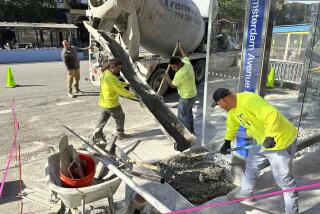Output Jump Inspires Optimism on Jobs : Economy: Reports show stable inventories and higher sales, indicating manufacturing losses may be over.
- Share via
WASHINGTON — Industrial production in October recorded its biggest increase in nearly a year and business inventories remained lean through September, raising hopes that the long decline in manufacturing employment may be ending.
A surge in auto manufacturing helped boost output at the nation’s factories, mines and utilities by 0.8% last month, the best since last November, the Federal Reserve Board said Monday.
“Most industries are increasing steadily, and that’s better than we could say six months ago,” said economist Priscilla Trumbull of WEFA Group, a Bala-Cynwyd, Pa., forecasting firm. “Growth has become much more dependable.”
The gain in the industrial production index was the fifth in a row. It followed a 0.4% rise in September.
The Fed said auto production jumped 7.3% in October and 3.9% in September after four months of either declines or no change. But even excluding motor vehicles, production rose 0.3% in September and 0.4% in October.
Trumbull said the consistency of the advances should eventually help persuade manufacturers to start hiring permanent employees. Fearing a relapse since the recession, they’ve relied on overtime and temporary help to keep production up.
“We don’t expect it will mean actual job gains for quite a few months, but we do think the loss of manufacturing jobs may be nearing an end,” she said.
In October, manufacturers expanded their payrolls by 12,000 jobs, ending a string of seven declines that brought factory employment to a 28-year low.
In a separate report, the Commerce Department said business sales rose 0.8% in September, the fifth increase in six months, far outpacing a moderate 0.3% increase in inventories.
The combination of strong sales and modestly increasing inventories are considered a positive sign for future factory production and employment. It means any increase in sales will probably translate quickly into new orders to factories.
“It suggests the pickup in industrial production is likely to continue for a couple months,” said economist Samuel Kahan of Fuji Securities Inc. in Chicago.
Both the production and inventory reports bolster analysts’ belief that the economy has left the doldrums of the first half of the year and entered a period of moderately healthy growth.
Recent production increases have caused a reciprocal rise in the operating rate at industrial firms. It was 82.4% of capacity in October, the highest since August, 1990, just after the recession started. It was 81.9% in September, 81.6% in August and 80.2% a year ago.
Economists worry that if capacity use increases too rapidly or goes much over 85%, it could lead to production bottlenecks and then inflation as goods in high demand become scarce. But the current level isn’t inflationary, Trumbull and Kahan said.
In October, manufacturing output advanced 0.9%, the strongest in a year. Output of durable goods--big-ticket items expected to last three or more years--increased 1.3% on top of a 1% gain in September. There were strong gains in appliances, televisions and air conditioners, 2.8%; computer and office equipment, 2.2%, and carpeting and furniture, 1.8%.
Outside of manufacturing, production fell 0.5% in mining, which includes oil drilling, and it edged up 0.1% at utilities.
Industrial Production
Seasonally adjusted index.
1987: 100
Oct., ‘93: 112.2
Capacity Utilization
Seasonally adjusted percent of total capacity:
Oct., ‘93: 82.4%
Source: Federal Reserve Board
More to Read
Inside the business of entertainment
The Wide Shot brings you news, analysis and insights on everything from streaming wars to production — and what it all means for the future.
You may occasionally receive promotional content from the Los Angeles Times.










